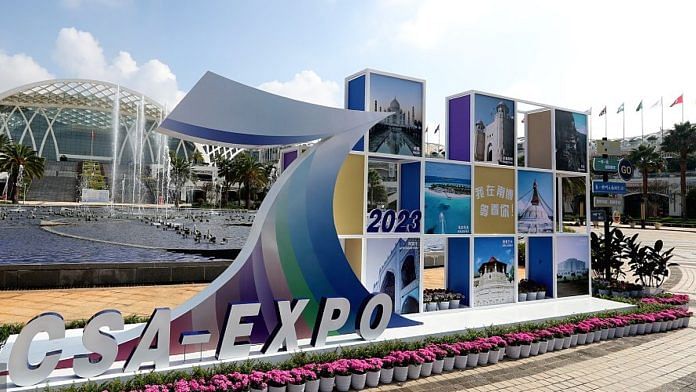New Delhi: Eyeing trade as a tool to expand its influence among India’s eastern neighbours, China is hosting a five-day China-South Asia exposition in Kunming, with Nepal featured as the ‘theme country’ and Myanmar the ‘guest of honour’.
Sri Lankan Prime Minister Dinesh Gunawardena, Nepalese Vice President Ram Sahay Prasad Yadav, Laotian Vice President Pany Yathotou and Vietnam’s Deputy Prime Minister Tran Luu Quang were among those who attended the opening ceremony on 16 August.
The 7th China-South Asia Expo marks the 10th year of the Belt and Road Initiative (BRI), and is the first to be held in person since after the Covid-19 pandemic.
In his opening remarks, Chinese foreign minister Wang Yi made suggestions for deepening strategic mutual trust, connectivity, economic and trade cooperation and cultural and people-to-people exchanges between China and South Asian countries, reported People’s Daily Online. Wang is also director of the Chinese Communist Party’s Office of Central Commission for Foreign Affairs.
After the devastating earthquake in 2015, Beijing had committed NPR 56.27 billion ($483 million) for post-earthquake rehabilitation in Nepal and another NPR 2.5 billion (about $21.47 million) to the Nepalese Army.
The signing of the Memorandum of Understanding (MoU) on Cooperation under the BRI on 12 May 2017 further opened new avenues for bilateral cooperation between the two countries. But the timely completion of projects stated to be under the BRI framework remains in question.
Unlike China, India’s focus has been on High Impact Community Development projects (HICDPs) which impact the lives of people at the grassroots level. At present, India is involved in the construction of schools, maternity hospitals and libraries in Nepal, besides the restoration of heritage buildings, sanitation and water irrigation facilities.
According to data from the Indian Embassy in Kathmandu’s official website and the PIB, India has invested in almost 136 projects in Nepal since 1950 till June 2023 at an estimated cost of NPR 265 billion. These include at least 10 hydropower projects.
Also Read: Lender on a bender? Why China’s bailing BRI nations out of defaulting on Chinese loans
No tangible plans implemented so far
The Ministry of Foreign Affairs of Nepal defines its relation with China as “age old and deep rooted and friendly & cordial”.
Nepal joined the BRI in May 2017 under the leadership of then prime minister Pushpa Kamal Dahal — who is also the current prime minister — with 35 projects initially identified for implementation. Later, this was reduced to nine which included the Kerung-Kathmandu railway line, the Rasuwagadhi-Kathmandu road upgrade, Galchhi-Rasuwagadhi-Keyrung 400kV transmission line and the Madan Bhandari Technical Institute.
With its stated focus on connectivity, trade and cooperation in economics, technology, among others, there are worries regarding the BRI’s lack of momentum in Nepal even six years later. Kathmandu claimed as recently as last month that no project under the BRI had been executed in Nepal yet.
“Nepal has only signed on the pact and no tangible plans or initiatives have been implemented so far,” Nepal’s Foreign Minister NP Saud was quoted as saying by Nepalese media outlets.
A number of projects were also delayed due to Covid-19 and internal political instability, among other factors.
With little to show six years after signing the BRI agreement, China has redoubled its efforts to expand the BRI beyond the listed projects. Earlier this year, Beijing unilaterally decided to place the Pokhara International Airport, constructed with Chinese assistance, under the BRI framework, despite the fact that it was not mentioned in the initial list of 35 projects.
However, the Chinese claims were later rejected by Nepal’s foreign minister who told The Kathmandu Post that the “project implementation plan of the BRI is still under consideration”.
This suggests that Nepal does not see the BRI as an overarching framework, but rather as project-specific. The number of stated BRI projects is now down to eight after India’s National Hydropower Power Corporation (NHPC) in June inked a deal with Nepal’s Vidhyut Utpadan Company for development of the 480MW Phukot-Karnali hydroelectric project.
According to a podcast by Marshall Meyer, emeritus professor of management at the University of Pennsylvania, recent events have demonstrated that China is struggling to find enough resources to fund the BRI projects.
Having to deal with a faltering domestic economy made worse by a trade war with the U.S. and more vociferous U.S. and European opposition to the BRI, flagship BRI investment projects have experienced delays or cancellations and Chinese finance has come under closer scrutiny due to worries about debt servicing and corruption, said Meyer.
This is an updated version of the report
(Edited by Amrtansh Arora)
Also Read: China’s failing white elephant projects in Sri Lanka have lessons for India



